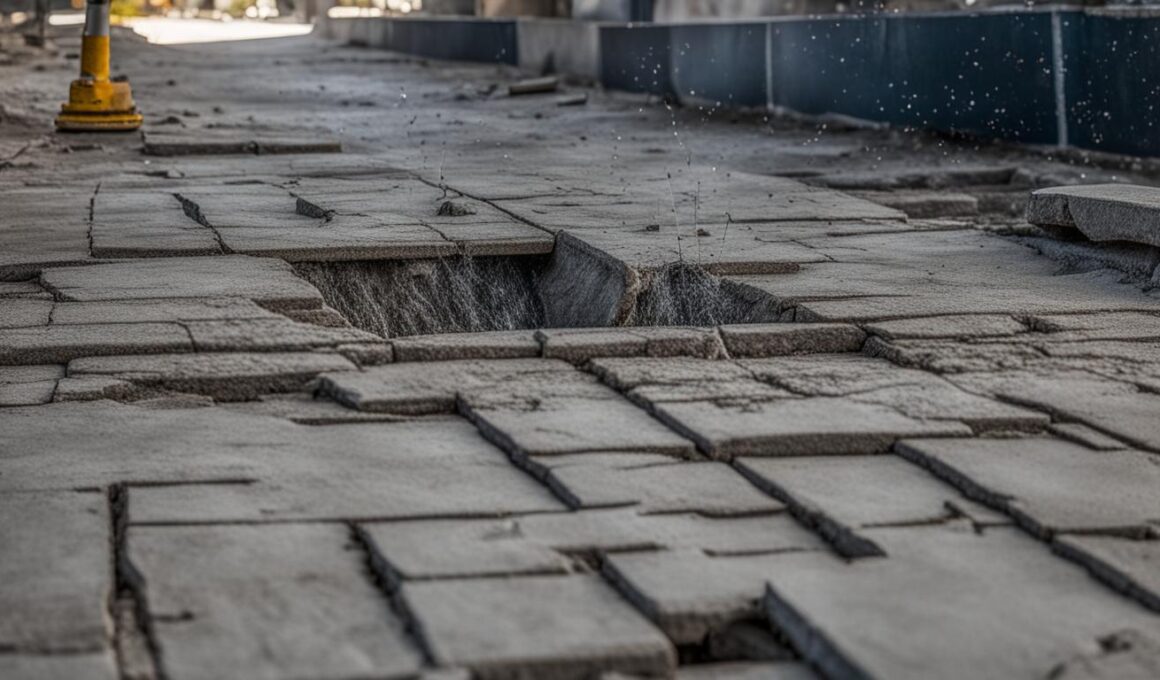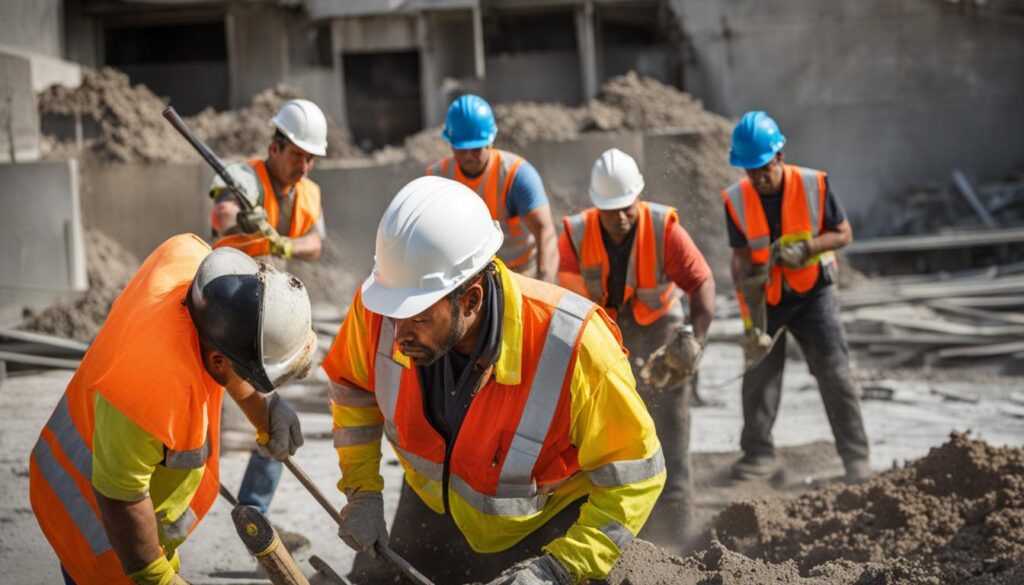Demolishing concrete can be a challenging task, but with the right know-how and tools, you can save time, money, and effort. In this guide, we will provide you with expert tips and techniques for efficient concrete demolition and removal, helping you tackle your construction challenges with ease. We will also discuss the cost-saving benefits of DIY concrete removal and provide recommendations for choosing the right tools for the job.
Key Takeaways:
- Demolishing concrete can be made efficient with the right techniques and tools
- DIY concrete removal can save you significant money compared to hiring a contractor
- Choosing the right tools, such as sledgehammers or jackhammers, is crucial for successful removal
- Planning the disposal strategy in advance is essential, considering options like concrete recyclers or trash containers
- Assembling a reliable crew for heavy lifting and teamwork can make the process smoother
Calculating the Cost-Saving Benefits of DIY Concrete Removal
When it comes to concrete demolition and removal, hiring a contractor can be a costly expense. However, by opting for a do-it-yourself approach, you can save a significant amount of money. Let’s take a closer look at the cost-saving benefits of DIY concrete removal.
For instance, removing a concrete driveway through professional services may cost around $1,400. But with DIY removal, you can complete the task for as little as $400, including rental and disposal fees. This substantial difference in cost highlights the potential savings that can be achieved by taking matters into your own hands.
It’s important to note that while the initial cost of DIY concrete removal may be lower, additional factors should be considered for a comprehensive cost analysis. One significant factor is the disposal costs. Depending on your area, you may need to pay fees to dispose of the concrete rubble. It is crucial to compare these costs with what a contractor would charge for removal.
By carefully calculating the overall savings and comparing them to contractor costs, you can make an informed decision about whether DIY concrete removal is the best choice for your project.
Image: Concrete Removal Cost-Saving Benefits
Choosing the Right Tools for Concrete Demolition
When it comes to concrete demolition, selecting the appropriate tools is crucial to ensure efficiency and effectiveness. The choice of tools largely depends on the thickness and size of the concrete you are working with. Let’s explore the options available:
Sledgehammer
A 12-lb sledgehammer can be surprisingly effective for demolishing thinner slabs, typically up to 4 inches thick. Its forceful impact can break apart the concrete, making it an accessible and cost-effective option for smaller-scale projects.
Jackhammer
For larger or thicker slabs, a rented jackhammer powered by a big compressor is the ideal choice. Jackhammers deliver powerful blows that can break through tough concrete quickly and efficiently. They provide the necessary force to tackle more substantial demolition tasks.
Electric Jackhammer
If you want to make the demolition process easier, consider renting an electric jackhammer. These tools are lighter in weight, making them more manageable for extended periods of use. Electric jackhammers are suitable for medium-sized jobs and provide versatility in various demolition scenarios.
However, for extra-large or thick slabs that require maximum power, a pneumatic jackhammer with a hose, bits, and a trailer-mounted compressor is the ultimate choice. This combination ensures a continuous and reliable supply of force to effectively break up the concrete. Pneumatic jackhammers offer the greatest power for demanding demolition projects.
By carefully selecting the right tool for your specific project needs, you can save time, effort, and ensure successful concrete demolition. Take into consideration the size and thickness of the concrete, as well as your own comfort and capabilities.
Note: The image shows a pneumatic jackhammer, which harnesses immense power to tackle even the toughest concrete demolition tasks.
Planning the Concrete Disposal Strategy
When it comes to concrete demolition, proper disposal is essential. You can’t simply toss it in regular trash cans. That’s why it’s crucial to plan your concrete disposal strategy in advance.
One option for disposing of concrete is to find local concrete recyclers. Some concrete recyclers accept concrete for free or charge a small fee per load. However, keep in mind that there may be additional charges if the concrete contains steel mesh or rebar. Recycling concrete not only helps with waste reduction but also contributes to sustainable construction practices.
Another disposal option is renting a trash container specially designed for concrete removal. These containers typically have a walk-in gate, making loading and unloading easier. Renting a trash container can be a convenient solution, especially for larger concrete projects where multiple loads need to be disposed of.
With various disposal options available, it’s important to consider factors such as cost, convenience, and environmental impact. Research local concrete recyclers and waste disposal services to determine the best option for your project.
Assembling a Reliable Demolition Crew
When it comes to concrete demolition and removal, heavy lifting is often involved, making it essential to have a reliable crew by your side. Assembling a team of individuals who can assist you with the physical demands of the project is crucial for a successful outcome. Here are some tips on how to form an efficient and reliable demolition crew:
- Plan ahead: Start by considering friends or family members who owe you favors and may be willing to lend a helping hand. It’s important to reach out to them in advance, allowing them to schedule their availability accordingly.
- Utilize heavy-duty wheelbarrows: Friends who own heavy-duty wheelbarrows can be especially valuable for concrete demolition projects. These tools can significantly ease the process of transporting rubble and debris, making the job more efficient.
- Consider the crew size: Ideally, your crew should consist of at least two individuals responsible for breaking up the concrete and a team of two to four people for hauling the rubble away. Having an adequate number of team members ensures that the workload is divided evenly, minimizing fatigue and maximizing productivity.
By assembling a reliable demolition crew, you can tackle the heavy lifting and teamwork required for your concrete demolition project more effectively. This collaborative effort will not only help you complete the task efficiently but also ensure the safety of everyone involved.
For a visual representation of how a reliable demolition crew works together, take a look at the image below:
Now that you have your crew in place, it’s time to ensure everyone’s safety during the concrete demolition process. Please continue reading for essential safety precautions and recommendations for personal protective equipment.
Ensuring Safety during Concrete Demolition
Safety should always be your top priority when it comes to concrete demolition. The process involves potentially dangerous elements such as flying shrapnel and debris, which can cause damage to property and result in serious injuries. To minimize these risks and ensure a safe and successful demolition, it is crucial to follow proper safety precautions and use personal protective equipment (PPE).
One effective measure to reduce the risk of flying shrapnel and debris is to cover the concrete slab with a protective sheet of plastic. This will help catch any shards or dust that may be generated during the demolition process, preventing them from causing harm or spreading around the worksite.
It is also important to use the correct technique when demolishing concrete to minimize personal injury and surface damage. If you are working on a smaller slab, prying and striking with a hammer may be sufficient. However, for larger or thicker slabs, using a jackhammer can make the process more efficient and safer. Be sure to follow the manufacturer’s instructions and wear the appropriate PPE.
To further enhance safety during concrete demolition, it is essential to wear the necessary personal protective equipment. This may include safety goggles, a dust mask or respirator, sturdy work gloves, and steel-toed boots. These items will provide protection against flying debris, dust inhalation, and potential foot injuries.
By following these safety precautions and using personal protective equipment, you can ensure that your concrete demolition project is carried out in a safe and secure manner. Always prioritize the well-being of yourself and those around you, taking the necessary steps to prevent accidents and injuries.
Conclusion
Concrete demolition and removal can be a challenging task, but with the right techniques, tools, and safety precautions, you can efficiently tackle your construction challenges. By opting for DIY concrete removal, you can save a significant amount of money compared to hiring a contractor.
Choosing the right tools for the job is crucial in ensuring a smooth demolition process. Consider the thickness and size of the concrete to determine whether a sledgehammer, jackhammer, pneumatic jackhammer, or electric jackhammer is most suitable.
Planning your concrete disposal strategy in advance is essential. Look for local concrete recyclers or consider renting a trash container with a walk-in gate for easier loading. By proactively assembling a reliable crew and ensuring they follow safety precautions, you can minimize risks and enhance the efficiency of your demolition project.
With efficient techniques, cost-saving benefits, and safety precautions in place, you’ll be well-equipped to successfully complete your concrete demolition and removal project. Take advantage of this expert guide to make your construction challenges more manageable, and save both time and money in the process.
Can I Use the Same Tools for Concrete Demolition and French Drain Installation?
Yes, you can use the same tools for concrete demolition and French drain installation. In this installing a french drain tutorial, you will see that tools such as a sledgehammer, jackhammer, shovel, and wheelbarrow are essential for both tasks. It’s important to use the right tools for each job to ensure efficiency and safety.
FAQ
Can I save money by doing concrete demolition and removal myself?
Yes, DIY concrete removal can save you a significant amount of money compared to hiring a contractor.
How much does DIY concrete removal cost compared to professional removal?
DIY concrete removal can cost as little as $400, including rental and disposal fees, while hiring a professional can cost around $1,400.
How do I choose the right tools for concrete demolition?
The choice of tools depends on the thickness and size of the concrete. For thinner slabs, a 12-lb sledgehammer can be effective, while larger slabs may require a rented jackhammer.
Where can I dispose of the concrete after demolition?
Some concrete recyclers accept concrete for free or charge a small fee, while another option is to rent a trash container with a walk-in gate for easier loading.
Do I need a crew to help with concrete demolition?
It’s beneficial to have a reliable crew to assist with the heavy lifting. You can ask friends or family members to help, ideally with heavy-duty wheelbarrows.
How can I ensure safety during concrete demolition?
To minimize risks, cover the slab with a sheet of plastic, use proper techniques, such as prying and striking or using a jackhammer, and wear personal protective equipment.











